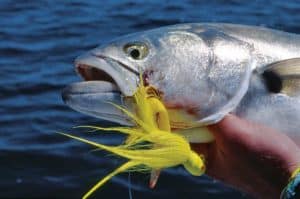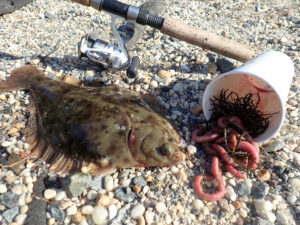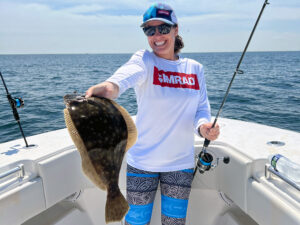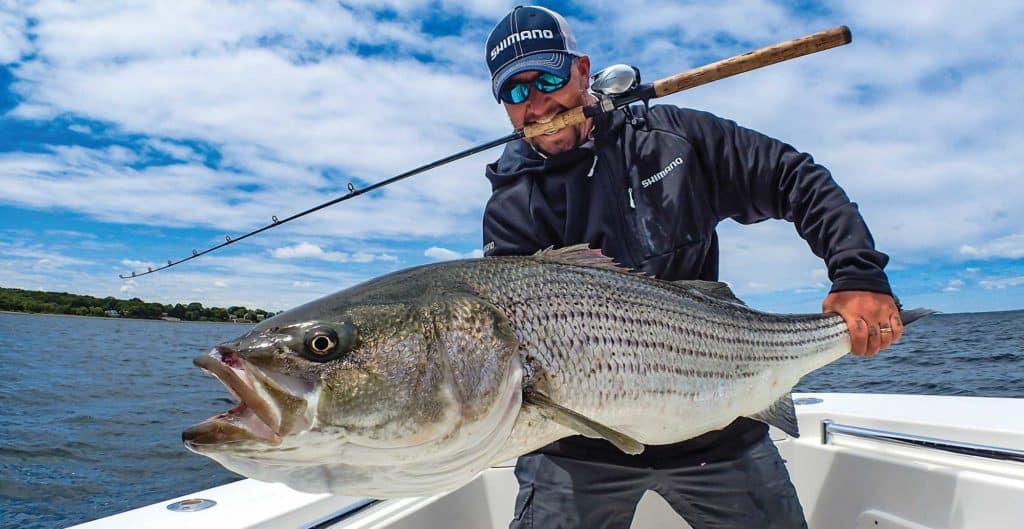
Recipes are great for both cooking and fishing — follow this set of instructions, and you’ll get that desired result. Professional chefs, however, understand which flavors combine well to create their own delectable dishes. Charter captains, who fish many days consecutively, through varied weather, temperature and tides, similarly understand how a lure’s specific characteristics — its flavor, if you will — mix with given water conditions to convince fish to take a bite.
With that in mind, I asked 11 striped bass experts to pick their favorite striper lure and explain when and how they fish it. I also asked each why he believed that particular lure to be so mouthwatering to striped bass in those circumstances. Sure, pro anglers typically name as their go-to striped bass lure one made by a manufacturer who sponsors them. But knowing it has proved consistently effective for them, then understanding why — both their “recipe” (what to fish, when and how — as well as their reasoning) — will help all striper enthusiasts increase their success. Here are the best striped bass lures you can buy today.
Quicklook: Best Fishing Lures for Striped Bass
- Hard Baits
- Soft Baits
- RonZ Original Series
- Lunker City Slug-Go
- Storm WildEye Swim Shad
- Berkley Gulp! Shads and PowerBaits (for East and West Coast Fishing)
Hard Baits
Gibbs Danny Surface Swimmer
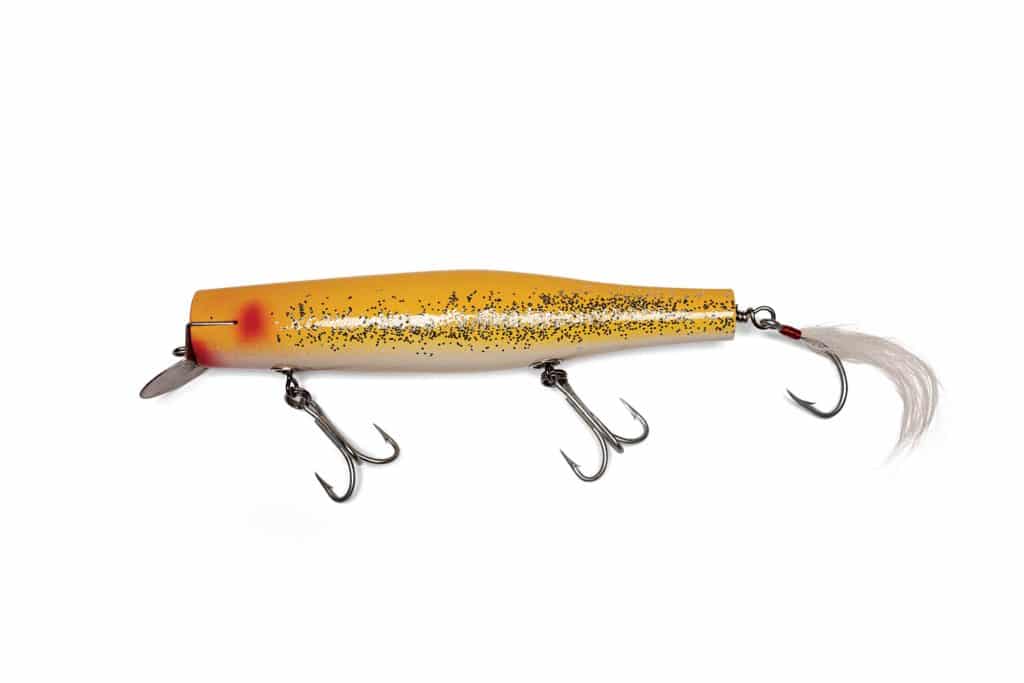
Where, When and Who Along Long Island on New York’s southwestern coast, from Jones Inlet to Fire Island, Capt. Al Lorenzetti targets striped bass on current edges along inshore sandbars from late May through mid-July, and then again in October and November.
Lure Choice and Conditions “When I’m anchored ahead of a rip, the blunt tip of the Danny, plus that metal lip, gives it a wobble that stripers want to pounce on, even with minimal forward motion through the water. Just the current makes the plug work.”
Read Next: Striped Bass Fishing in New England
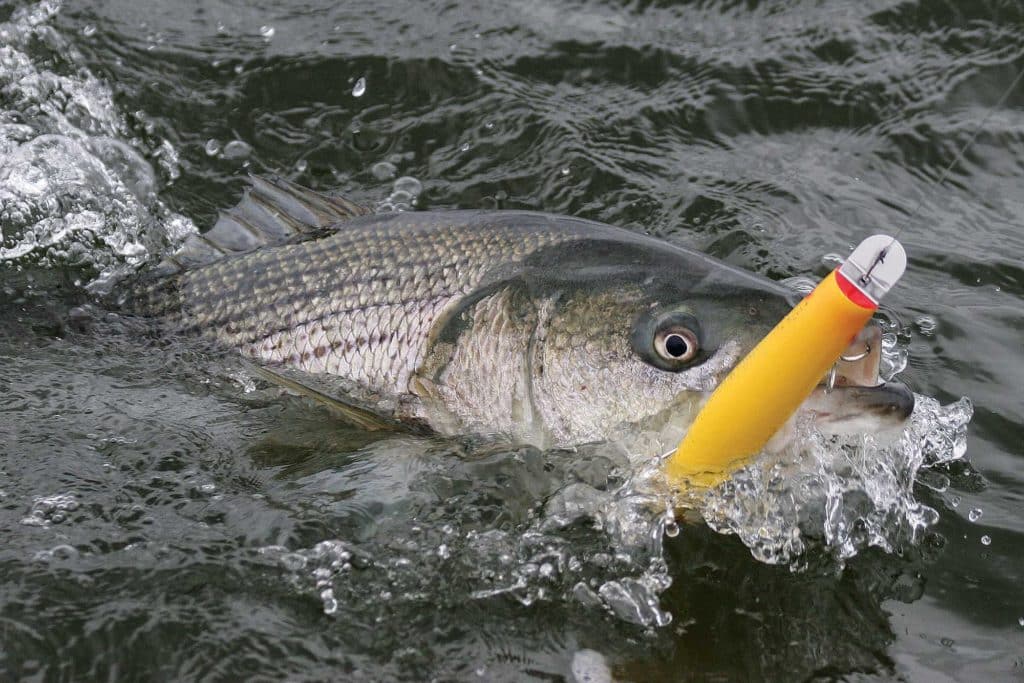
How and Why “One angler on one side of the boat just holds the lure right in front of the edge of the rip. Another angler on the other side casts behind the rip and reels right up to it. The most experienced angler in a group of three then throws between the two and reels the plug right along the rip line, just fast enough to make it wobble. It lays over side to side and looks like the slow-moving bunker or shad that frequent those rips.”
Size and Color 3½-ounce in yellow (which is intended to resemble bunker)
Unique Rig Bend the metal lip down, not quite to 90 degrees, to keep the lure on top, where it’s easier to keep an eye on it as well as see spectacular striper surface bites.
When to Switch “Casting into the wind, the line tends to foul the Danny’s front hook, and if I can’t get close, like at a breaking inlet bar, it doesn’t cast far enough.” At such times, Lorenzetti goes with Gibbs’ Polaris Popper. “It doesn’t foul, and I can throw it a country mile.”
-Lorenzetti is a pro staffer for Gibbs.
Rapala Skitter Walk
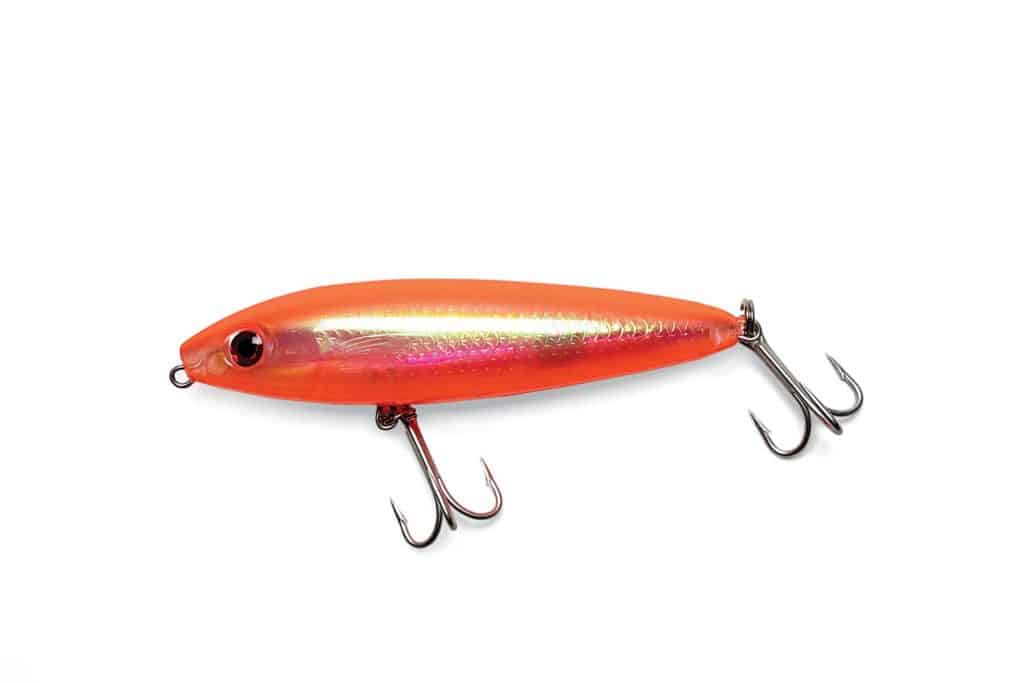
Where, When and Who North Carolina sounds — really, one huge, shallow inland sea — provide stripers year-round, with “dynamite action from late April through November,” says Capt. Gary Dubiel.
Lure Choice and Conditions If he knows where to cast, and stripers are either in shallow water or actively feeding on top, Dubiel says the distinct, loud rattle of the Skitter Walk attracts bigger fish than most other lures will.
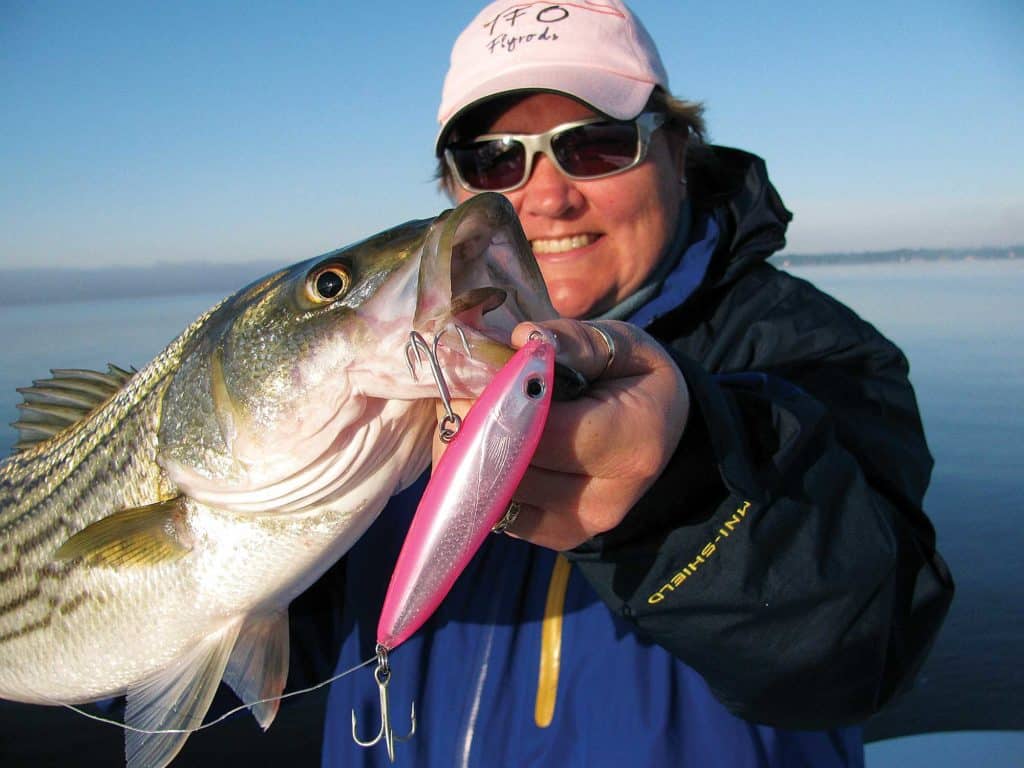
How and Why “Use a lot of rod tip and reel slowly” — the classic walk-the-dog, Dubiel says. “Rock the bait aggressively side to side to move that big rattle inside, and keep it moving toward you with slow momentum. The rhythmic noise and motion seem to trigger fish.”
Size and Colors 4 3/8-inch with a white or chartreuse belly, or — in particularly dark, tannic water — a model in orange hues
When to Switch In choppy water that muffles noise, or when fish are deeper or more scattered, Dubiel prefers the louder sound and heartier surface action of Storm’s Rattlin’ Chug Bug, a cup-faced popper, which he says is also easier for many anglers to fish properly.
-Dubiel is a pro staffer for Rapala.
Rebel Jumping Minnow
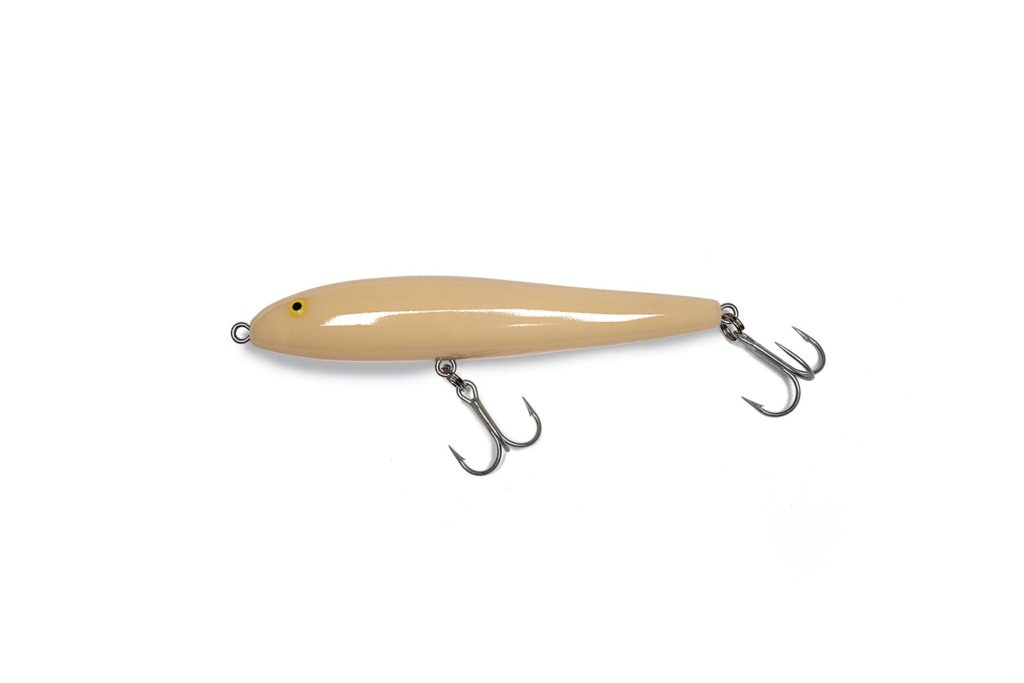
Where, When and Who Beginning in May, striped bass show up on bars and along marsh edges on the Merrimack River, just south of the Massachusetts/New Hampshire border, says Capt. Chris Valakatgis.
Lure Choice and Conditions “On a calm day, you see the Jumping Minnow on top, even if it stops, and you hear the rattle. That helps get you into a rhythm and adjust your retrieve until you find the cadence that entices bites.”
How and Why “Start with a slow walk-the-dog motion, then use slow twitches of the rod tip to make the bait swing out wider to the side. If stripers are breaking on the surface, try speeding up the cadence and tightening the zigzag.”
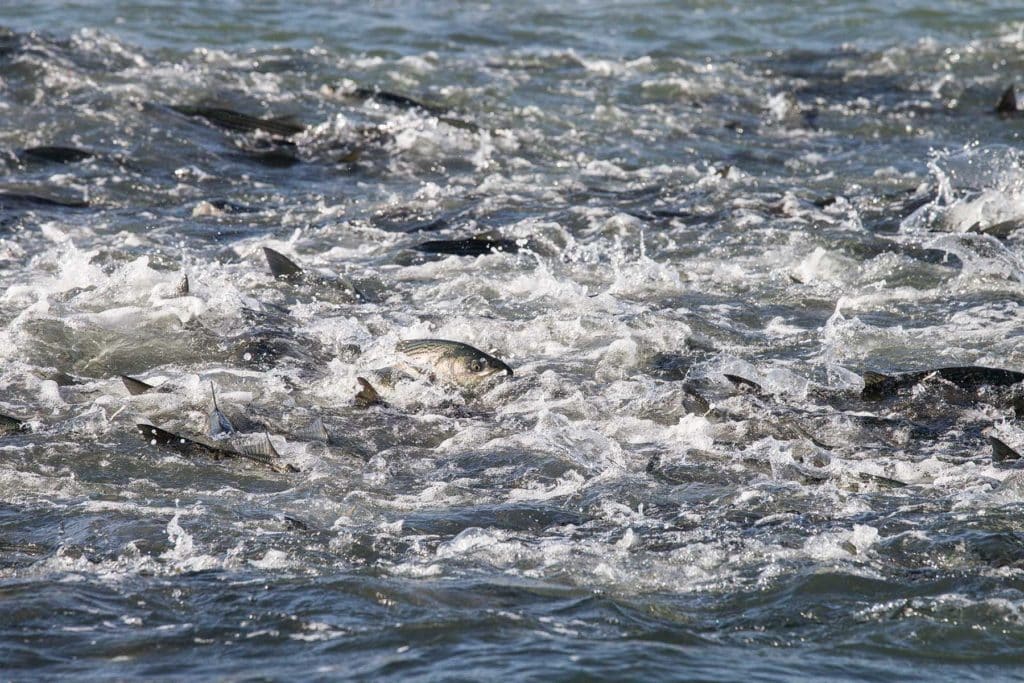
Size and Color 4½-inch in bone
Unique Rig Replace original hooks with larger No. 1 or No. 2 trebles to handle 40-inch fish, but crush barbs to aid releasing smaller schoolies.
When to Switch “The Jumping Minnow is so light, it’s hard to cast in any wind, and if it’s choppy, you need a lure with more surface commotion to stand out,” Valakatgis says, so in those conditions, he switches to the rear-weighted Cordell Pencil Popper for better casting and heartier action.
Sebile Magic Swimmer
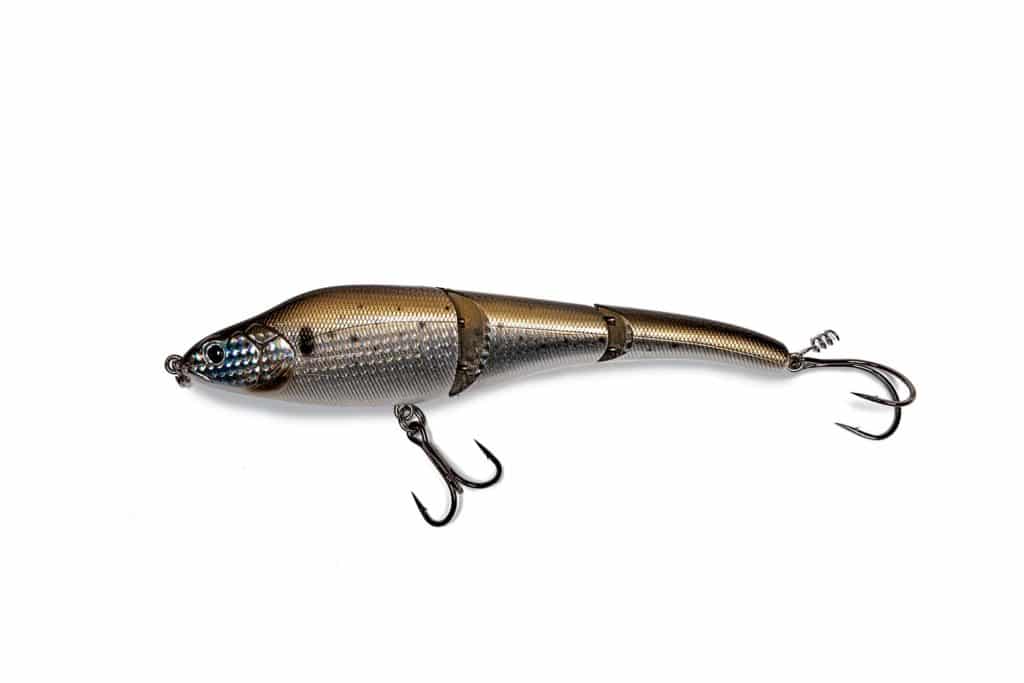
Where, When and Who After spawning in the Hudson and Delaware rivers, stripers return to the coast beginning late in March and hang there through June, says Point Pleasant Beach, New Jersey, Capt. John Luchka.
Lure Choice and Conditions “When adult bunker are around, the fast-sinking Magic Swimmer targets fish on the surface, midwater and all the way to the bottom,” Luchka says. Stripers are drawn to the vibration the jointed body creates and, the guide says, it looks like an injured fish once the fish get close.
How and Why “They’re not super aggressive until they’ve had a few meals. Cast the lure outside the edge of the bait school so it looks like a wounded bait separated from the school. Let it sink, then bring it in slowly a couple of cranks and pause, a couple more cranks, and pause. They crush it on that pause.” A faster retrieve entices those same fish after they’ve eaten and become more aggressive.
Size and Colors 7½-inch, 3-ounce fast-sinking in bunker, or the brighter American shad color in murky water
When to Switch When smaller prey are prevalent, Luchka prefers “Sebile’s Stick Shadd, which is a bit rounder, and better matches the body shape of peanut bunker.”
-Luchka was a pro staffer for Sebile, back when the company was producing lures.
Shimano ColtSniper Jerkbait
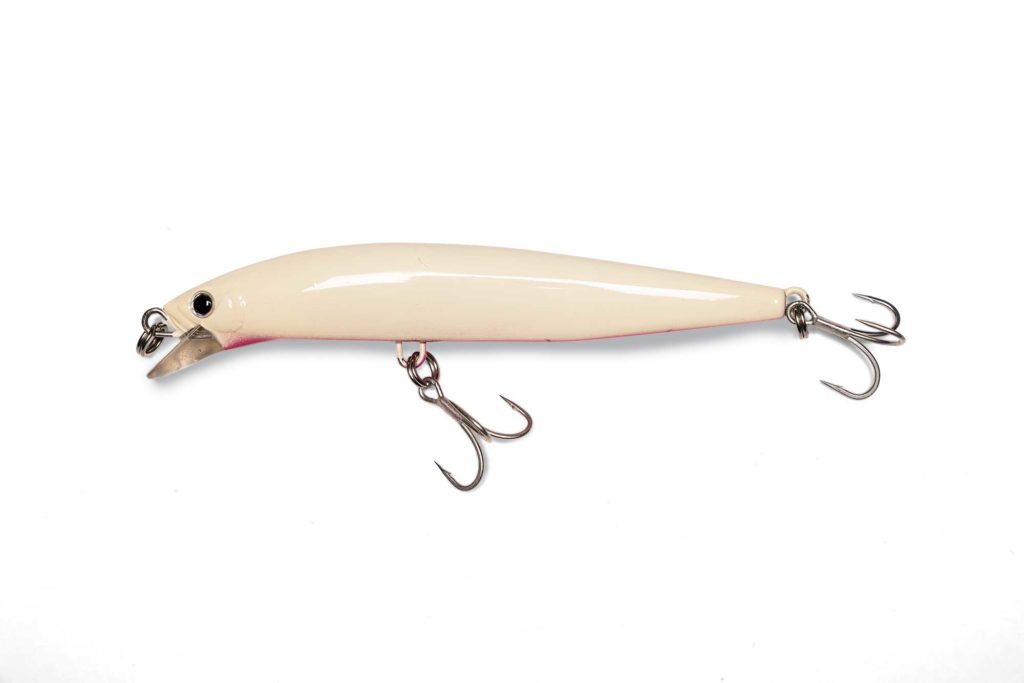
Where, When and Who Chris Fox’s flexible schedule gets him on the lower Chesapeake Bay as regularly as many pro captains where, from October through early December, he parlays that expertise into frequent striper, trout and redfish slams, all from one lure.
Lure Choice and Conditions Near the mouth of the York and James rivers, green shrimp — which are actually white — show up thick in shallow water near man-made structure such as old pier pilings. “The ColtSniper’s lip drives the lure underwater a foot or two, where the long, skinny body and white color match the shrimp.”
How and Why From deeper water, “cast it up on a flat and just reel it in slowly. It flashes white as it wobbles and rolls side to side. The fish usually hammer it right at that drop-off,” he says. As the water temperature falls below 50 degrees, “I slow the retrieve drastically, almost to the point of boredom,” he says — until a 40-inch striped bass piles on.
Size and Colors 140 mm (5.5 inches) in bone color with pink highlights underneath
When to Switch When the fish hang deeper than the ColtSniper will reach, “I switch to a sinking version of Hayward Tackle’s Genesis and twitch it for a walk‑the‑dog action.”
Strategic Angler Cruiser
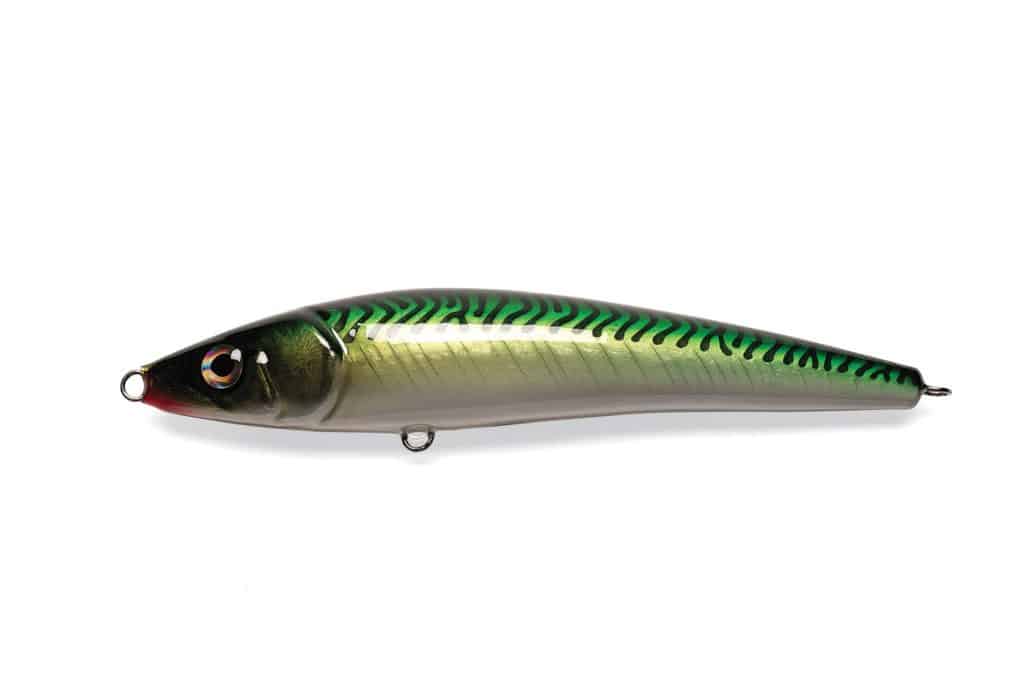
Where, When and Who Along Cape Cod’s eastern shore and north past Cape Ann, Massachusetts, from mid-May through mid-July, tremendous currents from 12-foot tides over bottom with minimal structure to hide behind force striped bass into huge, roaming packs. They’re “more like open-water pelagics” — not their normal ambush hunting style, says Capt. Dom Petrarca.
Lure Choice and Conditions For about an hour on either side of slack tide, Petrarca says, “the stripers push the mackerel to the surface and attack from underneath. The long, wide Cruiser makes a lot of surface noise and offers the mackerel profile that bass are keyed in to.”
How and Why “Every couple of cranks, give a light twitch to the left [for spinners with the handle on the left side]. The wide body is weighted so the narrow nose digs in and it kicks out to the side, then comes back in an S pattern,” Petrarca says, which mimics the quick lateral movements of mackerel fleeing predators.
Size and Color 10-inch in a blue- or green-mackerel pattern
Unique Rig Owner Stinger 3/0 treble hook plus a Gamakatsu 8/0 live-bait hook at the tail
When to Switch During ripping currents between high and low tides, striped bass change hunting tactics. “They stack up, looking like a long wave on the fish finder in the middle of the water column.” That huge wall of striper mouths swimming with the current sucks up any unfortunate prey it rolls across. “Get in front of the school, and drop a 3- or 4-ounce jig.”
-Petrarca is a pro staffer for Strategic Angler.
Tsunami Talkin’ Popper
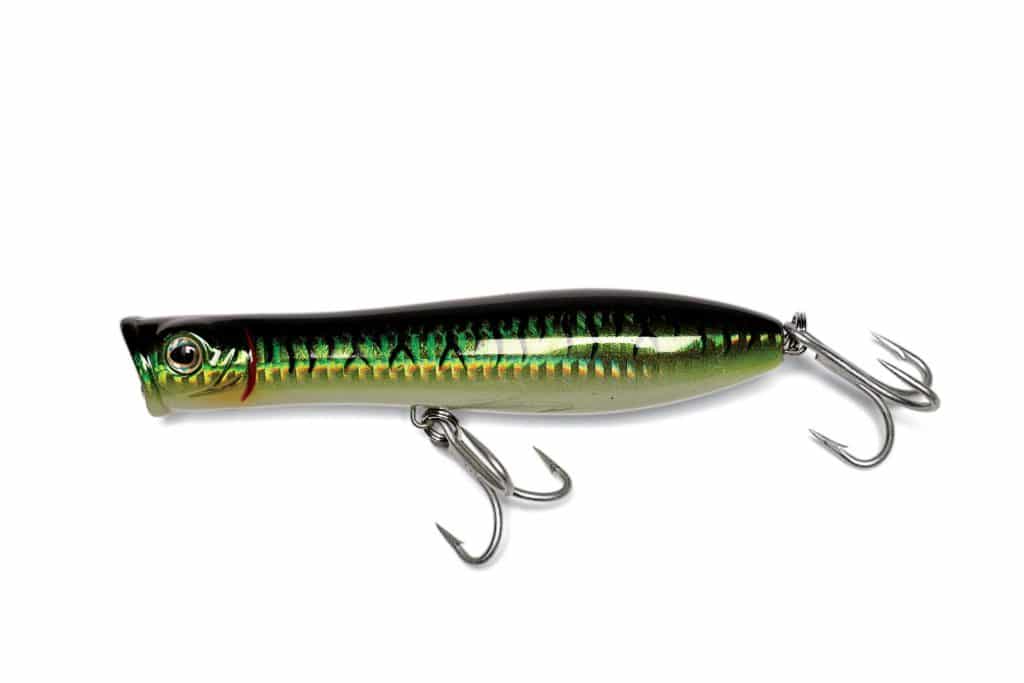
Where, When and Who Capt. Scott Leonard starts his season in May on Long Island, New York’s central south shore, and he moves to Montauk and beyond as the fish migrate east from July through September.
Lure Choice and Conditions “The Talkin’ Popper fishes really well when it’s flat or fairly calm — 12 knots of wind or less. It casts well too when stripers are up tight to the beach and hard to get to.”
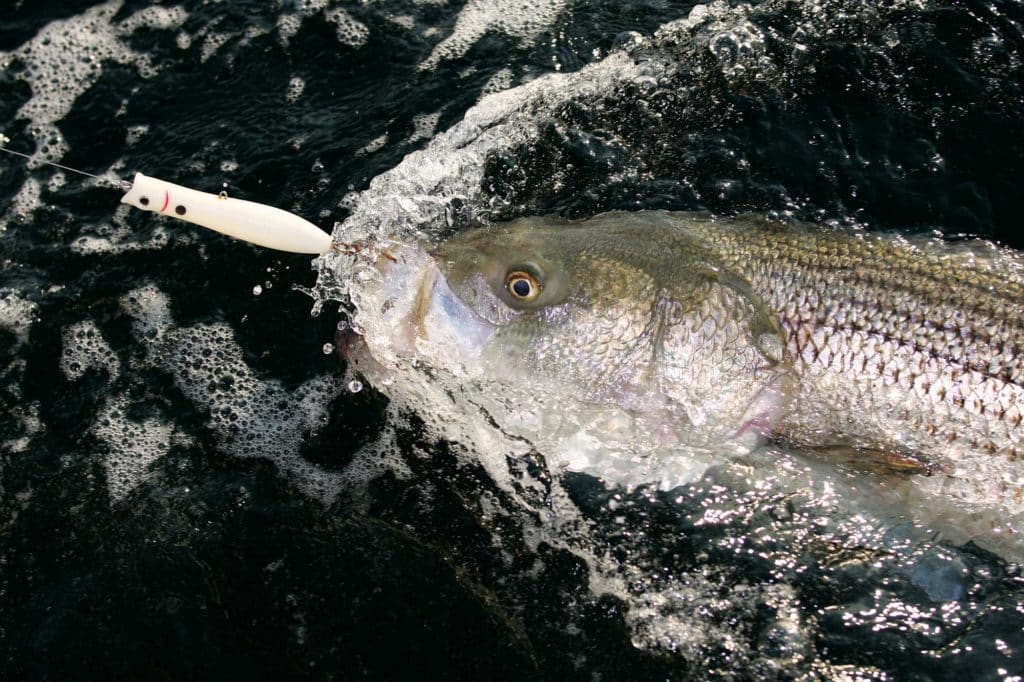
How and Why “Cast along the outer edges of the bunker school, where big bass tend to be. Pop it, let it settle, then pop it again, while reeling nice and slow. The slower the better for bigger fish,” he says. “The way it splashes, it looks like a wounded bunker separated from the school, and stripers climb right onto it.”
Size and Colors 3½-ounce in yellow, to mimic prevalent bunker
When to Switch “When conditions are rougher, with a lot of surface commotion already, I’ll go with a surface swimmer like the Gibbs Danny.”
-Leonard is a pro staffer for Tsunami.
Yo-Zuri Mag Darter
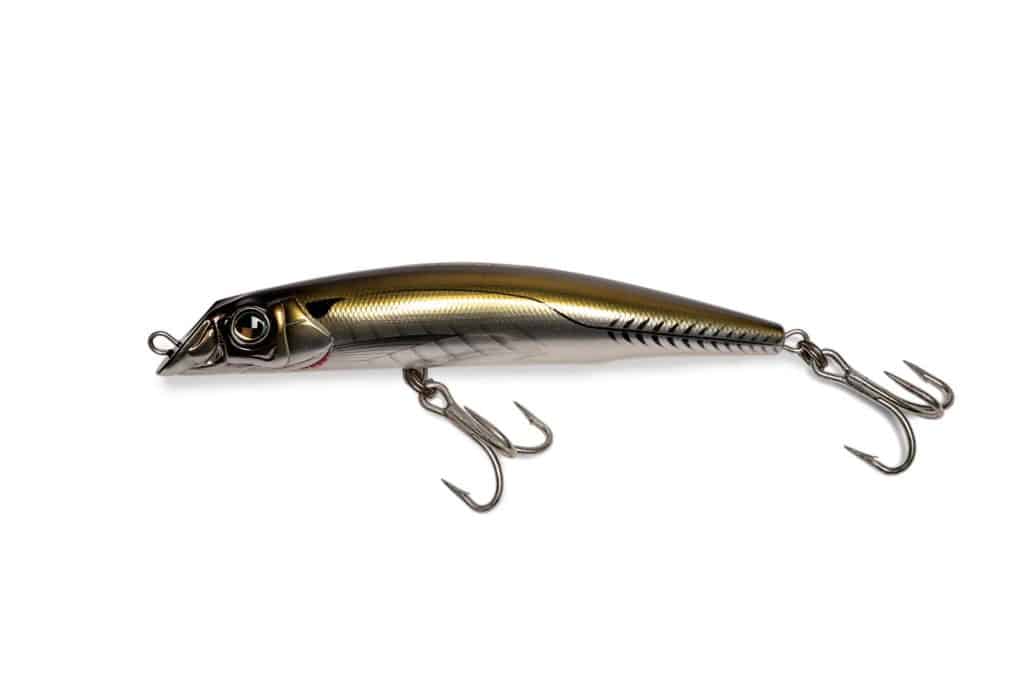
Where, When and Who Capt. Carter Andrews fishes far and wide for The Obsession of Carter Andrews television show, but he often returns to New England during peak early‑summer striper fishing.
Lure Choice and Conditions The Mag Darter fishes really well in strong New England currents. “It doesn’t roll to the side like a true lipped lure,” he says. “With the magnetic weight-transfer system, super-long casts maximize my opportunities farther from the boat.”
How and Why “With just a slow, steady, straight wind, it darts really well side to side,” which he says entices striped bass in most conditions. To spice it up, though, “on every second or third crank, I give it just a little twitch.”
Size and Colors 6½-inch in bronze or bone, or, at times, holographic pink
When to Switch “When I’m up the rivers, in calmer conditions with less current, I can throw the 5-inch Mag Minnow like a dart,” he says, to more accurately target specific points and pockets of marsh grass where striped bass might lie.
-Andrews is a pro staffer for Yo-Zuri.
Soft Baits
Hard baits require specific angler actions to convince stripers they’re a natural food source. “Soft baits already look and feel real,” says Rhode Island charter captain Jack Sprengel, who offers several hot tickets.
RonZ Original Series
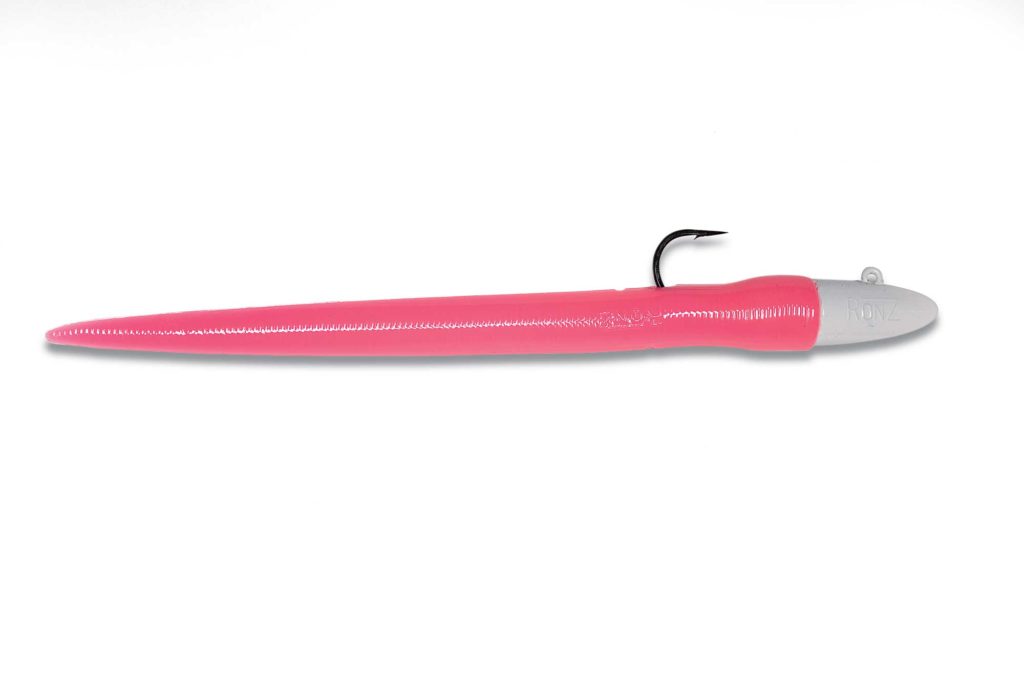
Early in July, as fish move into deeper water off Block Island, Sprengel says, “they’re often using current breaks behind structure to carry feeding opportunities to them. The original RonZ series lure’s tapered body swims just from water moving across its body.” Simply drop a 6- to 8-inch lure from a drifting boat, choosing the weighted head based on drift speed. Alternately, “cast into the direction of the drift and let it sink to the bottom, then slowly jig it all the way back to the surface.”
-Sprengel is a pro staffer for RonZ.
Lunker City Slug-Go
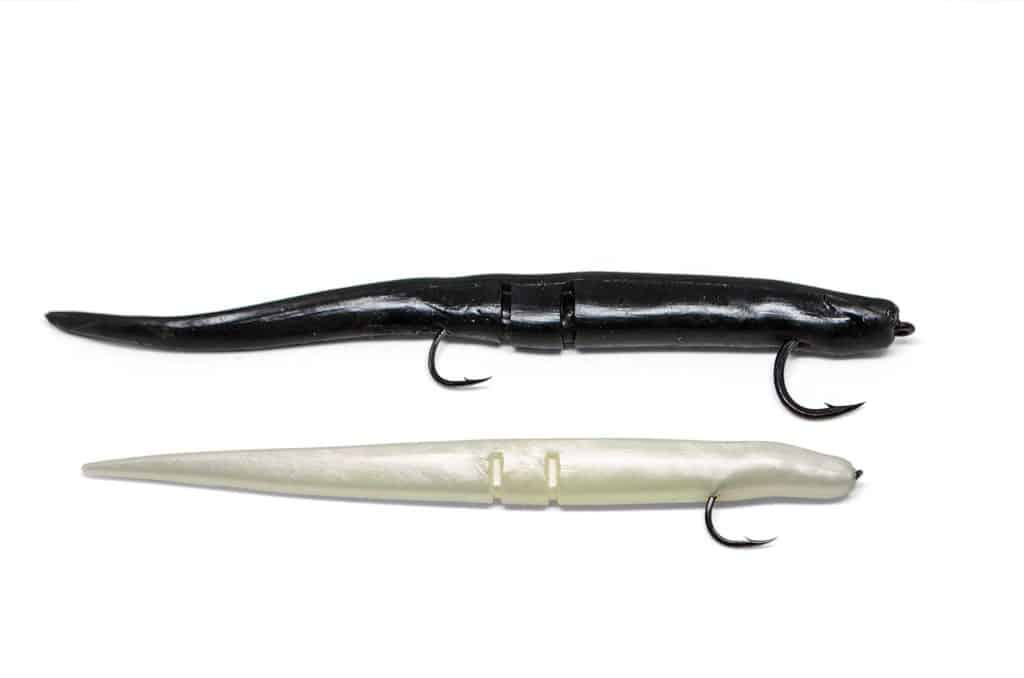
Beginning in May in Narragansett Bay, “when they’re in shallow water and easily spooked, it’s tough to beat a soft-landing, slow-moving bait like the original Slug-Go, presented at or just below the surface,” Sprengel says. A 6- to 10-inch bait should be rigged with a single-hook head. “Less is more. Don’t botch the presentation by adding too much input. If the strike doesn’t come right after it lands, retrieve any slack, give it two sharp twitches, pause, and repeat.”
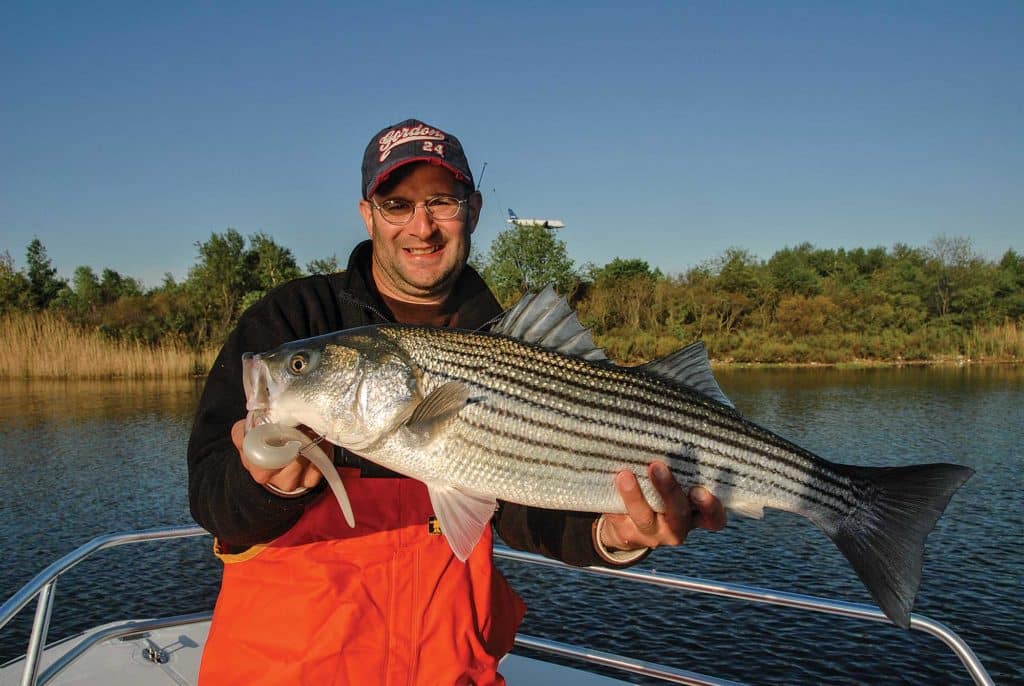
Storm WildEye Swim Shad
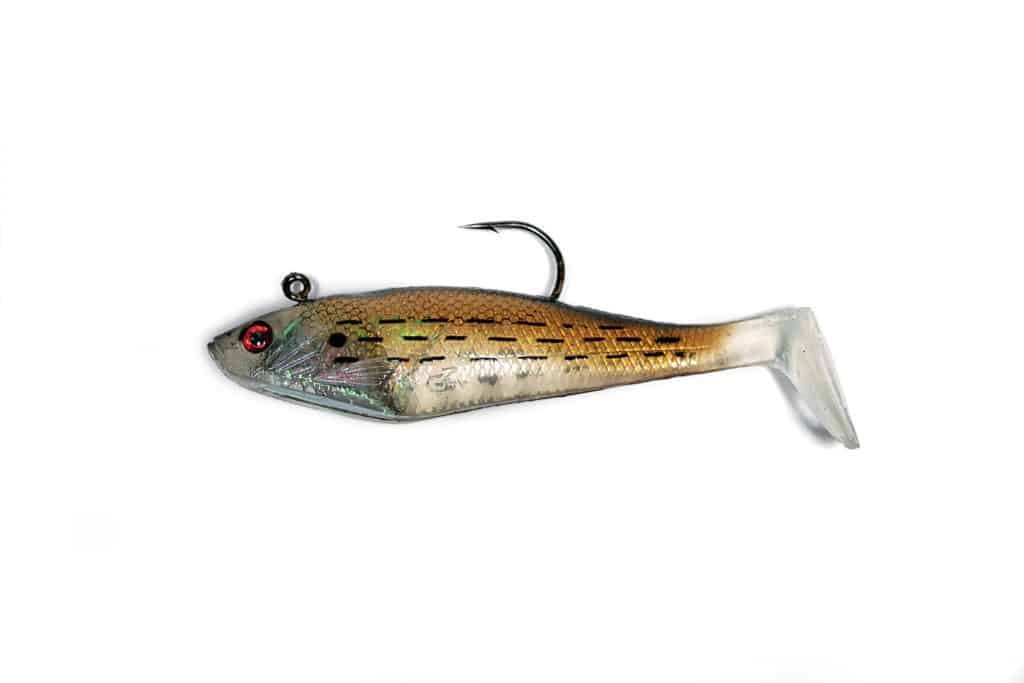
Regarding another favorite of Sprengel’s, he says: “Near a jetty or pier, a weighted paddle-tail shad with tight but erratic action, such as Storm’s swim shad, sinks quickly down into the strike zone along and between structure contours.” Start small, 4 to 6 inches, or as large as 9 inches to target large stripers. “Reel slowly and let the paddle tail do its job.” Sprengel favors these swim shad in bright colors on bright days and darker colors on dark, overcast days. “Hold the lure over your head,” he suggests, “and see how it contrasts with the sky — as fish will see it.”
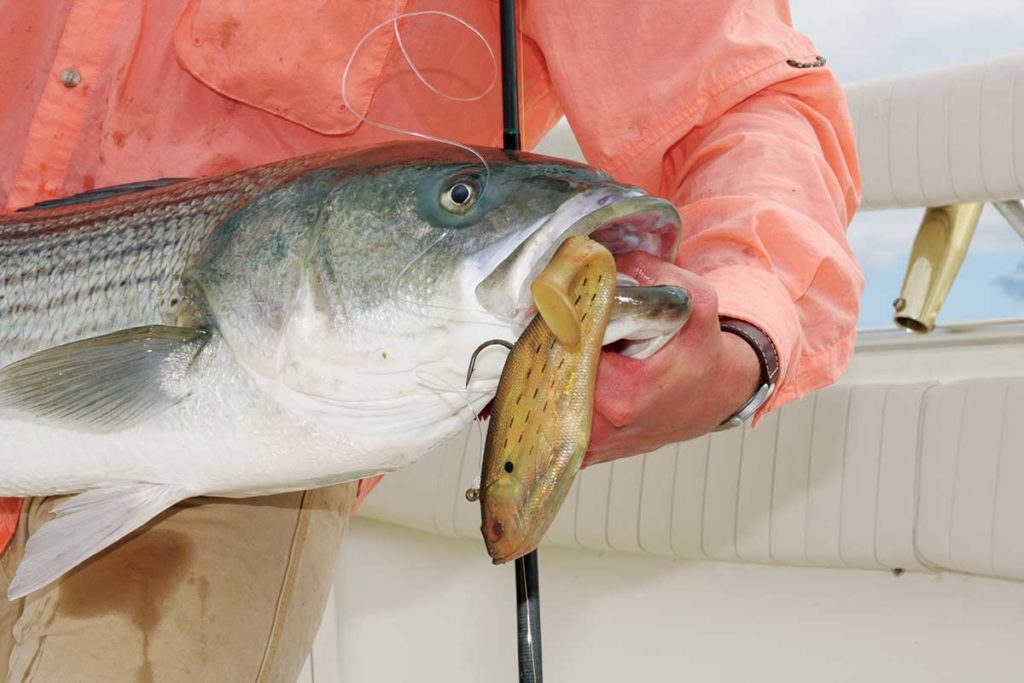
Berkeley Gulp! Shads and PowerBaits (East and West Coast)
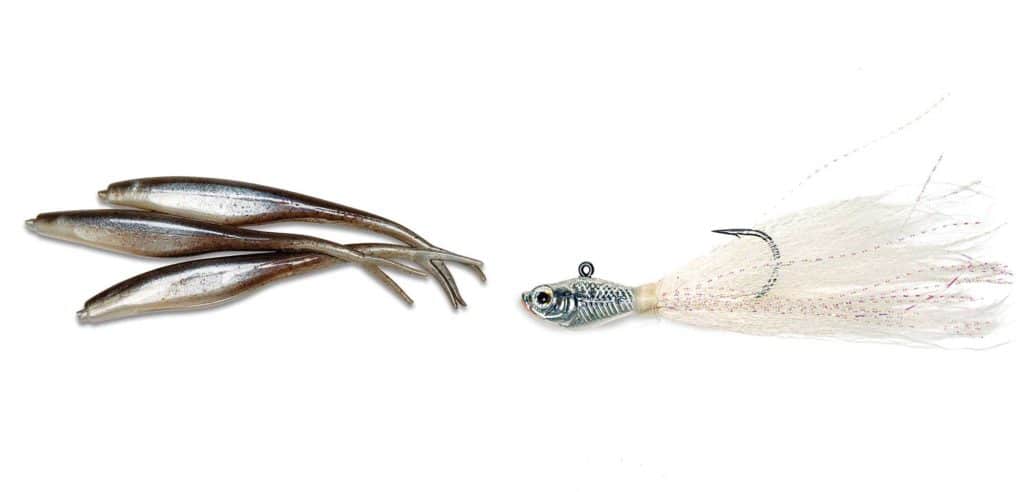
With a West Coast spin on striper fishing, widely known Northern California fishing journalist Steve Carson says: “On major rivers, the 8-inch black PowerBait Maxscent Kingtail rigged on a ½- to ¾-ounce jig head replicates local eels. In the California Delta, Berkley’s 4-inch Havoc Sick Fish and 4- or 5-inch PowerBait Ripple Shad are good for blind-casting at known holding areas, or cast the Gulp! 5-inch or 6-inch Saltwater Jerk Shads into visible boils. Carson adds, “Shad- or trout-replicating colors are usually best, though chartreuse can be very effective in dirty water.”
-Carson is a pro staffer for Berkley.
Back on the East Coast, pro tournament fisherman Capt. Seth Funt (@teamthreebuoys) says, “The fish in Long Island Sound in March and April are tuned in to worms and small sand eels,” so he opts for a ½- or ¾-ounce Spro Prime Bucktail Jig in pearl, tipped with a 4- or 6-inch Gulp! Power Worm in pumpkin color. “It gives them a big, fat sand eel to get excited about. Just twitch, twitch, pull, and then let it fall a little. Worms and juvenile eels don’t swim along like baitfish; they just move with the current, so present it the same way.”
Try Them Out for Yourself
No matter your preferred striper lure, the key is to match it to the seasonal patterns and feeding behaviors of the striped bass you’re targeting. With the right lures and some well-timed casts, you’ll be hooking into plenty of these hard-fighting fish in no time. So get rigged up with some proven striped bass lures and get out on the water — the next trophy is waiting for you.

